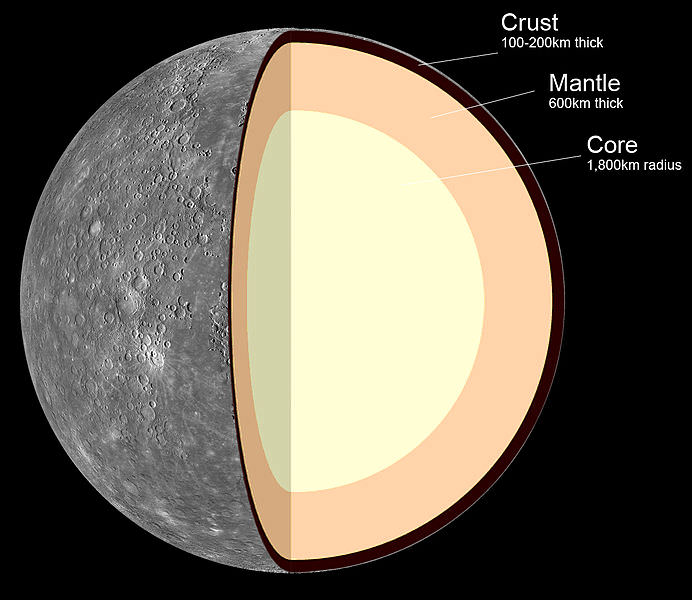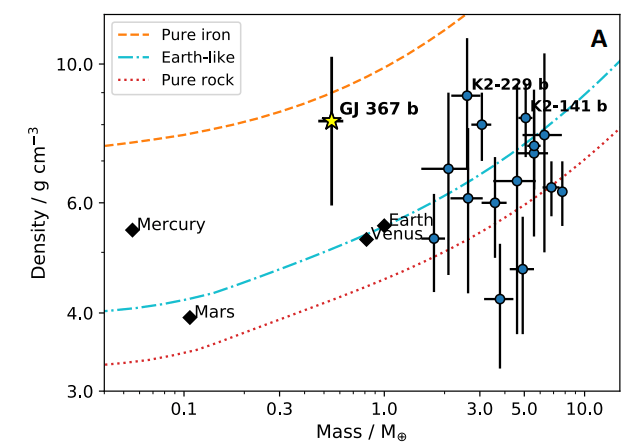Some planets orbit their stars so closely that they have extremely high surface temperatures and extremely rapid orbits. Most of the ones astronomers have found are Hot Jupiters— planets in the size range of Jupiter and with similar compositions as Jupiter. Their size and proximity to their star make them easier to spot using the transit method.
But there’s another type of planet that also orbits very close to their stars and has extremely high surface temperatures. They’re small, rocky, and they orbit their star in less than 24 hours. They’re called ultra-short-period (USP) planets and TESS found one that orbits its star in only eight hours.
And the planet’s density is almost equivalent to pure iron.
The planet orbits a red (M-type) dwarf star named GJ 367 about 31 light-years away. It’s named GJ 367b and it’s about 70% as large as Earth and about 55% as massive. Astronomers call it a sub-Earth.
The discovery is detailed in a new paper published in Science. Its title is “GJ 367b: A dense ultra-short period sub-Earth planet transiting a nearby red dwarf star.” The first author is Kristine Lam, currently a Post-Doctoral Researcher at the German Aerospace Center (DLR.)
“We’re finding a Mars-sized planet that has the composition of Mercury,” said study co-author Roland Vanderspek, a principal research scientist at MIT. “It’s among the smallest planets detected to date, and it’s spinning around an M dwarf on a very tight orbit.”
Sub-Earth’s can be very difficult to detect around other stars because they’re so small. Their small size makes their transit signals extremely weak, and their low masses mean they barely tug on their host stars. In this case, the detection was a little easier because the star it orbits is also a small M-dwarf.
Sub-Earths usually have no atmosphere because their stars strip it away. They have neither enough mass nor a strong enough magnetic field to retain their atmospheres.
“Why is this planet missing its outer atmosphere? How did it move close in? Was this process peaceful or violent?”
GJ 367b is no different.
Its surface is showered with about 576 times more radiation than Earth is and there’s no way an atmosphere can withstand that intensity. All that solar radiation means the surface temperature is around 1500 C (2700 F; 1775 K.) Any atmosphere would have been stripped away by all that energy, and of course, no living thing could withstand it either.
It has no atmosphere and no chance of supporting life, but it’s an extremely interesting exoplanet for another reason: its density.
Because the planet is so close to its star, astronomers were able to measure some of the planet’s other properties, something difficult to do with other USPs. Though TESS found the planet initially, follow-up observations with the HARPS (High Accuracy Radial Velocity Planet Searcher) instrument at the ESO’s La Silla Observatory determined that the planet is rocky and likely has a core of solid iron and nickel, similar to Mercury. Those observations also helped determine the planet’s size and mass.
From there they determined that the iron core makes up 86% of GJ 367b’s interior.
 The discoverers of GJ 367b say that the exoplanet’s structure is similar to Mercury’s. This image shows the internal structure of Mercury: 1. Crust: 100–300 km thick 2. Mantle: 600 km thick 3. Core: 1,800 km radius. Credit: NASA/JPL
The discoverers of GJ 367b say that the exoplanet’s structure is similar to Mercury’s. This image shows the internal structure of Mercury: 1. Crust: 100–300 km thick 2. Mantle: 600 km thick 3. Core: 1,800 km radius. Credit: NASA/JPLWhile the interior structure of the exoplanet is similar to Mercury, the planet and its situation are like nothing in our own Solar System. And its discovery begs a bunch of questions.
“Understanding how these planets get so close to their host stars is a bit of a detective story,” said TESS team member Natalia Guerrero. “Why is this planet missing its outer atmosphere? How did it move close in? Was this process peaceful or violent? Hopefully, this system will give us a little more insight.”
We know that planets can migrate from the original position they formed in. Jupiter did so. The working theory of planet formation is the nebular hypothesis. Briefly, the nebular hypothesis states that after a star forms, the leftover material forms a protoplanetary disk that planets form from. But the nebular hypothesis places some limitations on where planets can form.
Planets can’t form as close to their star as GJ 367b is. There’s less material available for planetary formation that close to the star, and the temperatures are too high for material to condense into solids. Rocky planets like GJ 367b can’t form there. According to the paper, the surface temperature is high enough to “… begin to melt and vaporize any silicates or metallic iron.” They must form further out and migrate in somehow.
 This figure from the study illustrates GJ 367 b’s density in relation to other similar-sized rocky planets. Its density is closer to pure iron than other planets, and it likely has an iron core that makes up 83% of the planet’s radius. Image Credit: Flam et al 2021.
This figure from the study illustrates GJ 367 b’s density in relation to other similar-sized rocky planets. Its density is closer to pure iron than other planets, and it likely has an iron core that makes up 83% of the planet’s radius. Image Credit: Flam et al 2021.Planetary migration is a complex topic and there are different types of migration. Basically, planetary migration takes place when there’s still a significant disk of gas around a young star. As the planets move through the gas, they exert a gravitational influence on the gas itself. That triggers an equal and opposite force on the planet, which can change its angular momentum. Depending on the particular circumstances, there can be either an inward or an outward migration.
What happened in GJ 367b’s solar system is unclear, but astronomers will likely study it further.
“It’s like there’s a sign saying, ‘Look here for extra planets!’ “
GJ 367 is an M-type star or red dwarf. They’re known to often host multiple small planets, with some estimates saying they host an average of 2.5 planets of less than four Earth radii, with orbital periods less than 100 days. And since M-dwarfs are low mass themselves, it’s somewhat easier to detect planets around them. “Due to the small stellar radius, the transit signal produced by a planet orbiting an M dwarf is larger than a planet of the same size orbiting a solar-type star (G dwarf),” the authors write in their paper.
A similar principle holds true for radial velocity measurements. “The radial velocity (RV) signal induced by a planet is also larger for an M dwarf host than for a G dwarf, due to the lower stellar mass,” the authors write. “M dwarfs, therefore, provide an opportunity to search for exoplanets with small radii and low masses.” However, M dwarfs also have higher stellar activity, which adds some difficulty to accurate RV measurements.
“Since this star is so close by, and so bright, we have a good chance of seeing other planets in this system. It’s like there’s a sign saying, ‘Look here for extra planets!’ “said team member George Ricker, a senior research scientist in MIT’s Kavli Institute for Astrophysics and Space Research.
M dwarfs may be unlikely to support life on nearby planets because they can flare so powerfully. That flaring would sterilize any planet that wasn’t already too close to being too hot for life, like GJ 367b. But if the star hosts other planets further out, could they be habitable?
“For this class of star, the habitable zone would be somewhere near a month-long orbit,” said Ricker.

